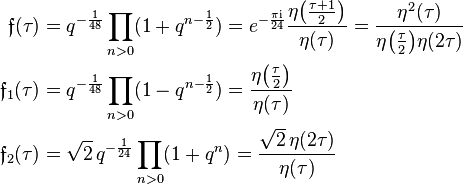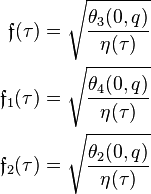Weber modular function
In mathematics, the Weber modular functions are a family of three modular functions f, f1, and f2, studied by Heinrich Martin Weber.
Definition
Let  where τ is an element of the upper half-plane.
where τ is an element of the upper half-plane.
where is the Dedekind eta function. Note the eta quotients immediately imply that,
is the Dedekind eta function. Note the eta quotients immediately imply that,
The transformation τ → –1/τ fixes f and exchanges f1 and f2. So the 3-dimensional complex vector space with basis f, f1 and f2 is acted on by the group SL2(Z).
Relation to theta functions
Let the argument of the Jacobi theta function be the nome  . Then,
. Then,
Thus,
which is simply a consequence of the well known identity,
Relation to j-function
The three roots of the cubic equation,
where j(τ) is the j-function are given by  . Also, since,
. Also, since,
then,
See also
References
- Weber, Heinrich Martin (1981) [1898], Lehrbuch der Algebra (in German) 3 (3rd ed.), New York: AMS Chelsea Publishing, ISBN 978-0-8218-2971-4
- Yui, Noriko; Zagier, Don (1997), "On the singular values of Weber modular functions", Mathematics of Computation 66: 1645–1662, doi:10.1090/S0025-5718-97-00854-5, MR 1415803







